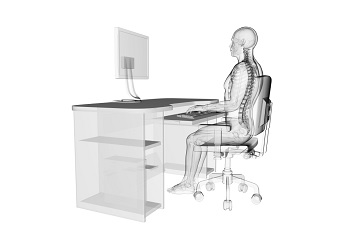Although office and administrative work is largely considered low risk, that shouldn’t make office safety any less of a priority. Office workers can still be exposed to preventable hazards that could cause an injury or illness. Workplace injuries and illnesses can have many negative repercussions, including disrupting daily operations, reducing employee morale and increasing costs associated with workers’ compensation claims.

Here are four of the most common types of office worker injuries and ways to reduce their occurrence.
Slips, Trips, and Falls
According to the most recent Bureau of Labor Statistics report, more than 20,000 office and support workers sustain injuries from slips, trips, or falls. In many cases, these types of injuries can be prevented by taking the following simple actions:
- Keep floors and walkways clear of potential tripping hazards such as stray papers, boxes, or deliveries. Do not stretch cords across hallways. If the hallways are carpeted, make sure the carpets remain in good condition and have them replaced if they become buckled or torn.
- Provide proper ladder safety training and follow the manufacturer’s instructions. Employees should never use chairs, boxes, or tables to reach items on a high shelf.
- Avoid slippery floors. Linoleum and tile floors can be particularly slippery when wet. If it’s raining or snowing, use weather mats at entrances, or if water spills, make sure to mop up any wet areas quickly and post signs warning people to be careful of slippery surfaces.
- Hold on to handrails when taking stairs or ramps. If you are carrying a heavy load, use an elevator.
- Avoid running, stay alert when walking, and do not turn corners or open doors too quickly.
Struck by Objects
- Close file cabinet drawers after each use. Full file cabinets can tip over if too many drawers are left open.
- Do not place file cabinets near doors or in high traffic areas of the office.
- Stow supplies safely. Large stacks of heavy boxes or other materials can cause serious injury if they topple. Keep heavy box stacks low and close to the floor. Make sure storage units are properly anchored to the wall and be careful not to overload shelves.
Ergonomic Injuries
Musculoskeletal disorders (MSDs) such as carpal tunnel syndrome, tendonitis, and back, neck, and shoulder strain are common and costly causes of office worker injuries. However, these injuries can be significantly reduced and even prevented by ergonomic workstations, which can be set up inexpensively.
- Make sure chairs, desks, and monitor stands are adjusted to fit individual workers. Educate workers on how to set up their desk and how to properly adjust equipment. Chairs should be positioned so that the employee’s feet are flat on the floor, and the back of the chair is configured to a 100 to 110-degree reclined angle. The keyboard should be centered in front of the monitor so the employee doesn’t have to strain to reach it. The Occupational Safety and Health Administration (OSHA) provides additional information on proper ergonomics.
- Reduce fatigue. Employees who spend many hours inputting from hard copy to a computer could benefit from using a document holder. Proper placement of a document holder can reduce eye strain, head and neck fatigue, and headaches. A good rule of thumb is to place the document holder at the same height and distance from the employee as the monitor.
- Ensure the keyboard and mouse are at the same level. Some offices offer a pull-out tray for the keyboard, but the mouse is on the desktop. This can lead to neck and shoulder pain.
Eye Strain
According to the American Optometric Association (AOA), computer vision syndrome, also known as digital eye strain, is an eye and vision-related problem that can result from prolonged exposure to a computer, tablet or cell phone. A couple of simple actions can help mitigate this everyday hazard.
- Take a break. Because the average American worker spends seven hours a day on the computer, the AOA recommends workers follow the 20-20-20 rule: take a 20-second break to view something 20 feet away every 20 minutes.
- Reduce overhead lighting by removing some of the bulbs and provide individual task lamps. Fluorescent, “canned” lights are common in many office buildings but can be too bright.
By taking proactive steps to prevent workplace hazards, employers can help reduce worker injuries and improve office safety. For more information, contact EMPLOYERS.
| Raul Chacon is Western Region Loss Control Manager for EMPLOYERS®, America’s small business insurance specialist®, which offers workers’ compensation insurance and services through Employers Insurance Company of Nevada, Employers Compensation Insurance Company, Employers Preferred Insurance Company, and Employers Assurance Company. Not all insurers do business in all jurisdictions. EMPLOYERS and America’s small business insurance specialist are registered trademarks of Employers Insurance Company of Nevada. For more information, e-mail losscontrol@employers.com. |
